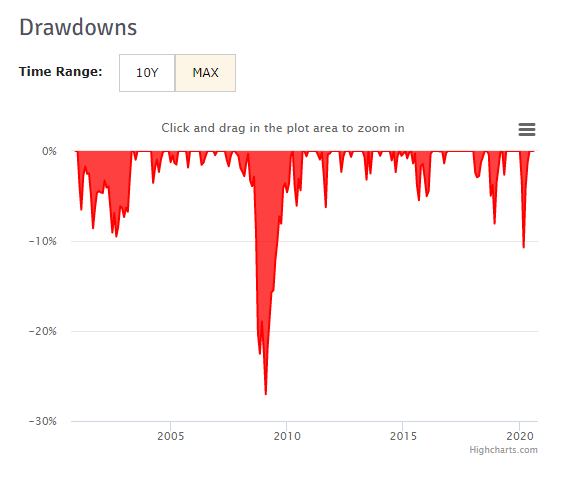Scott Burns investment approach can be summarized in 2 words: simplicity and low cost. And guess what? It worked! Over the last 10 years, the portfolio obtained an annualized return of 9.41% with limited drawdown*.
(* past returns are not indicative of future returns)
Who is Scott Burns?
Scott Burns is a newspaper columnist and author who has covered personal finance and investments for over 30 years. He is known for creating the "Couch Potato Portfolio" investment strategy, which advocates the use of index funds over managed funds or stock-picking. In 2006, he co-founded the Web startup AssetBuilder.com, where he serves as chief investment strategist.
What is the Couch Potato Portfolio?
Scott Burns created the Couch Potato Portfolio in 1991. The Couch Potato Portfolio is about as simple as it gets: a 50/50 mix of stocks and bonds, using only 2 funds. Burns maintains that this simplicity makes it probably the most accessible and easy-to-understand portfolio out there, stating that anyone who “can divide by 2” can understand it.
The basic premise for the 50/50 allocation is that stocks can drive returns while bonds help protect against stock crashes and lower the portfolio’s volatility. The portfolio is essentially a slightly more conservative version of a traditional 60/40 portfolio.
Interestingly, adherence to Burns’s precise prescription of funds for the Couch Potato Portfolio doesn’t seem to be required and varies among investors. That is, you could use an S&P 500 index fund, total US stock market fund, or total world stock market fund on the equities side. On the bonds side, you could use intermediate treasuries, total bond funds, Treasury Inflation Protected Securities (TIPS), etc.
Burns submits that more important than the fund choices are the fundamental requirements of low-fee indexing, diversification, and simplicity, and states that “the single most important thing is the basic 50/50 mix of stocks and bonds.” This is consistent with Burns’s writings on investing; he aims to be “an antidote to Wall Street.” The idea is that you can sit on the couch, check and rebalance this portfolio once a year, and let it do its thing.
Burns describes the implementation of the Couch Potato Portfolio in an article from 1991. Here are some direct quotes from the article:
“Try this: once a year – like when you add new money – you take the total value of your investment and divide by 2. That tells you how much you need in stocks. And in bonds. So you move some money, as necessary, from stocks to bonds. Or vice versa. With telephone exchange privileges at most mutual fund families, you can do this is less time than it takes to go to the refrigerator. Indeed, as a timing exercise, I suggest you put a medium sized potato in your microwave: your annual portfolio management will be done in less than the 10 minutes it takes to cook the potato”.
How to replicate the Scott Burns Couch Potato Portfolio through ETFs
The website www.lazyportfolioetf.com attempts to replicate the Scott Burns Couch Potato strategy through a 100% ETF asset allocation.
It's a Medium Risk portfolio and it can be replicated with 2 ETFs (source: www.lazyportfolioef.com):

The portfolio is highly liquid and can basically be liquidated or rebalanced in 2 clicks.
As mentioned earlier, the choice of the ETF is arbitrary. The VTI ETF could have been replaced by the VOO (S&P 500) ETF, which less diversified than the VTI as only invested into 500 large caps. Another option would have been to use the VT (Total World stock market) ETF which would have increased diversification by investing in non-US stocks. Both solutions work.
Same story on the bond side. The use of a Treasury bond ETF such as GOVT is favored by some investors. Another solution is to allocate into a Total bond market ETF. The main advantage of the TIP ETF is to protect purchasing power in case of a rise in inflation (more on this later).
Historical returns and volatility
In the last 10 years, the portfolio obtained a 9.41% compound annual return, with a 7.45% standard deviation.
In 2020, the portfolio is up +9.41% as of the end of August. It was up +19.51% in 2019. The worst yearly return was in 2008 with a performance of -18.47%.
You will find below monthly and yearly returns since 2001. You will also find historical returns and statistics over various time periods as well as historical drawdowns (source: www.lazyportfolioetf.com) 

 (past returns are not indicative of future performance).
(past returns are not indicative of future performance).
Last word
The 50% equities / 50% bonds approach to achieve long-term success has been coded into Wall Street’s DNA for decades, and provided solid returns for almost as long.
But increasingly, financial specialists argue that the Fed’s Quantitative Easing policy has suppressed bond yields while inflating equity valuations — keeping the 50/50 split from working the way it’s supposed to. McCulley thinks this “disinflationary environment” that made the 50/50 mix the best risk-adjusted approach actually reflects larger systemic problems in the U.S. economy. As such, many strategists advocate for a more diversified approach which includes the use of alternative investments such as real estate. Others believe that active (instead of passive) investing could soon come back with a vengeance.
We note, however, that the two ETFs used in the aforementioned portfolio might not be the worst performing ones in case of a change of paradigm on the inflation side. For instance, US equities posted decent returns in the past when inflation picked up. And TIPS would most likely outperform other US Treasury investments.
Read our next article:Top 7 tweets of the day





